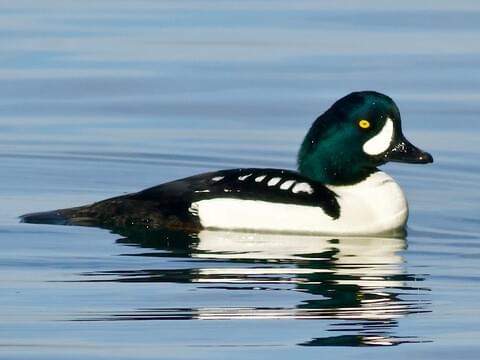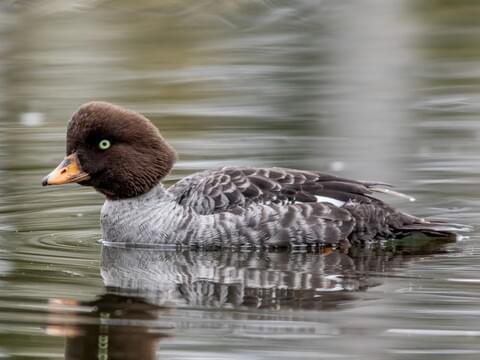Barrow’s Goldeneye


Scientific name: Bucephala islandica
Alternative names: Barrow Duck, House Duck (Icelandic: húsönd)
Measurements
| Feature | Male | Female |
|---|---|---|
| Length | 49 cm (19.2 in) | 43 cm (17 in) |
| Weight | 970 g (2.13 lb) | 590 g (1.31 lb) |
| Wingspan | 70–73 cm (27.6–28.7 in) | 70–73 cm (27.6–28.7 in) |
Status
Listed as Least Concern by the IUCN. While its range is limited, the global population is stable, with strongholds in northwestern North America and Iceland.
Identification
A compact, medium-sized diving duck often confused with the Common Goldeneye. Males have a purplish-black head with a distinctive white crescent near the bill, a black back, and bright white flanks. Females are browner overall with yellow bills and rounded heads. The species’ golden eyes and rapid wingbeats producing a sharp whistle make it easily recognizable in flight.
Voice
Generally quiet except during courtship, when males produce soft croaks, grunts, and squeaks. Their wings emit a noticeable whistling sound in flight.
Diet
Feeds mainly by diving for aquatic insects, small crustaceans, mussels, and snails. In coastal areas, they rely heavily on marine crustaceans like Gammarus oceanicus and Calliopius laeviusculus. Vegetation and mollusks also form part of their diet.
Distribution
Breeds across northwestern North America, parts of eastern Canada, and Iceland. Outside the breeding season, they migrate to sheltered coastal waters and large inland lakes. Rare vagrants have been recorded in western Europe, with only a few sightings outside Iceland.
Habitat
Prefers wooded lakes, ponds, and forested rivers for nesting, especially areas with mature trees that offer natural cavities. During migration and winter, they frequent estuaries and protected coastal bays.
Breeding
Nests in tree cavities or occasionally in burrows or ground crevices. Females return to the same nesting sites annually. After breeding, both sexes move to molting sites—safe wetlands rich in food—where they remain flightless for 20–40 days until their feathers regrow.
Behavior
Territorial and aggressive, particularly among males defending nesting or feeding areas. Pairs form strong seasonal bonds, often reuniting in wintering grounds after being apart during molting. They are agile divers and fast fliers, capable of swift, direct movement across open water.
Conservation
While populations remain stable, localized threats include oil spills and habitat disturbance. The 1989 Exxon Valdez oil spill notably reduced their numbers in Alaskan wintering areas due to contamination of coastal mussel beds. Continued habitat protection is vital to maintaining healthy populations.
